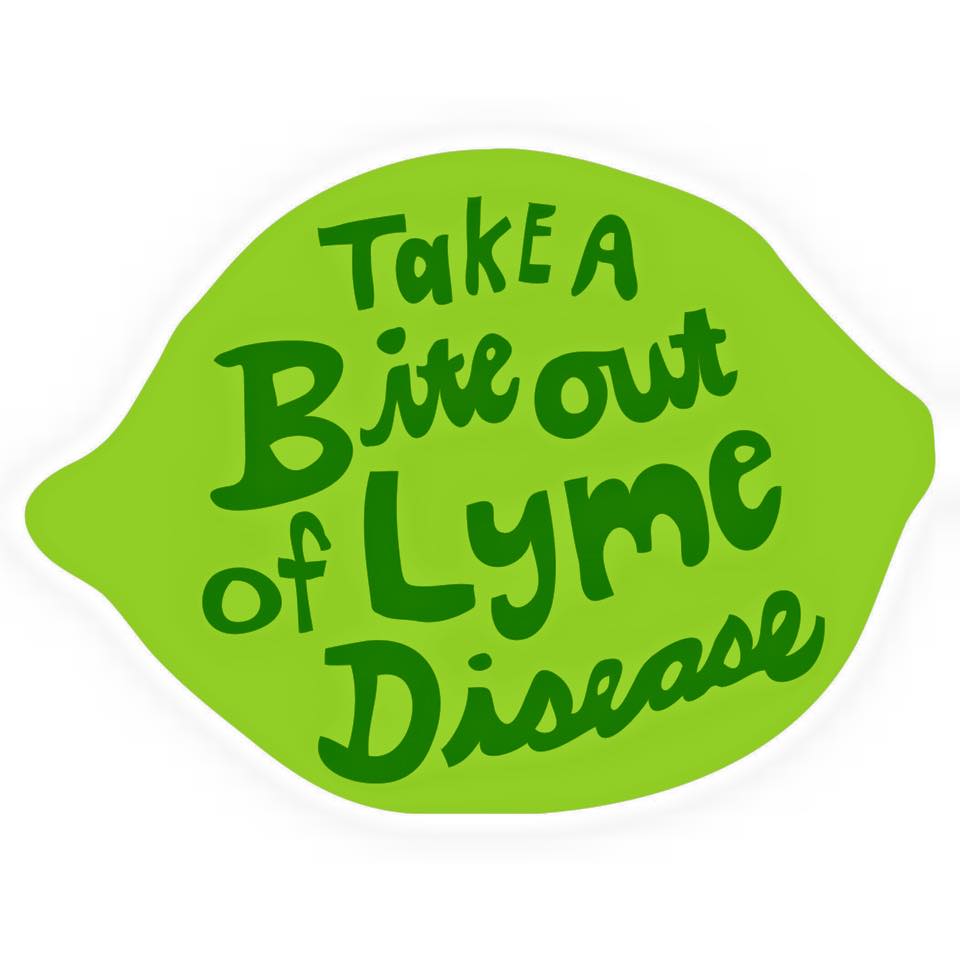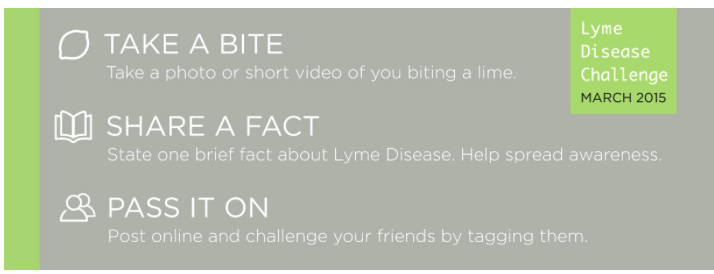Join the Lyme Disease Challenge: Help Change the World!
 Tuesday, February 24, 2015 at 06:26PM
Tuesday, February 24, 2015 at 06:26PM  Why a Lyme Disease Challenge?
Why a Lyme Disease Challenge?
Lyme Disease is one of the fastest-growing infectious diseases in the country. In fact, the Centers for Disease Control (CDC), recently described Lyme Disease as a “tremendous health problem.” The CDC estimates that there are at least 300,000 new cases each year in the United States alone, with a significant percentage suffering chronic symptoms even after standard antibiotic treatment. The purpose of the Take a Bite Out of Lyme Disease Challenge is to raise awareness and funds to improve diagnosis and treatment. All proceeds will go to International Lyme and Associated Diseases Educational Fund (ILADEF), the 501(c)(3) non-profit of the International Lyme and Associated Diseases Society (ILADS).
“Although there are clear benefits of uniting for an awareness campaign considering the millions suffering worldwide,” states Melissa Bell, one of the Challenge organizers, “the efforts have been hampered by the fact that many with Lyme are suffering from debilitating symptoms making it difficult to attend physical events. Additionally, patients often cannot afford to participate due to medical bills not covered by insurance, and those afflicted are dispersed geographically. Social media has provided Lyme sufferers with a vital framework for both support, as well as advocacy.” Bell states “Facebook in particular has provided an invaluable platform for patients to receive support from others who understand the complexities of Lyme Disease and associated infections.” We are “thankful that social media is available to provide a true lifeline for those suffering from chronic, isolating illnesses or those who have children suffering from these conditions.”
How Does the Lyme Disease Challenge Work?
Beginning March 1, 2015, participants are asked to follow the three easy steps below and make a $10 donation. Those who prefer not to take the bite, can donate $100 instead.
 About Lyme Disease
About Lyme Disease
Lyme Disease is caused by a spirochete (spiral shaped) bacteria (Borrelia burgdorferi) and is primarily transmitted by ticks. Children ages 5 - 14 are at the greatest risk of acquiring Lyme Disease and constitute approximately 25% of all reported cases. According to research, children are bitten by ticks more frequently around the head and neck, making them more vulnerable to brain and central nervous system infections. Infants can also become infected by Lyme Disease and related infections during pregnancy.
Lyme is called the “great imitator,” because it can mimic conditions such as multiple sclerosis (MS), amyotrophic lateral sclerosis (ALS), fibromyalgia, lupus, chronic fatigue syndrome, Parkinson’s disease, Alzheimer’s disease, and autism. Ticks harbor many other diseases that can be transmitted to humans aside from Lyme Disease, including other bacterial infections, viruses or parasites. Indeed, there are many diseases (some life-threatening) carried by ticks that can complicate tick-borne disease diagnosis, treatment and recovery, including Babesiosis, Tularemia, Anaplasmosis, Mycoplasma, Ehrlichiosis, Rocky Mountain Spotted Fever, Borrelia miyamotoi, Bartonella, Heartland virus, Powassan virus, the newly discovered Bourbon virus, among others.
Those suffering from Lyme Disease and co-infections are challenged in all aspects of diagnosis, treatment, and research funding. The average patient sees five doctors over nearly 2 years before being diagnosed. In a recent survey, approximately half reported not being properly diagnosed for more than 10 years. Delays in diagnosis are due in large part to misinformation and the fact that the two-tier testing paradigm for Lyme Disease recommended by the Centers for Disease Control (CDC) misses approximately half the actual cases pursuant to numerous peer-reviewed studies. There is a deep division within the medical community as to how patients should be treated if they do not respond to a standard course of antibiotics lasting several weeks, leaving many patients without effective care or insurance coverage. Chronic Lyme Disease may be long lasting, may significantly impair patient quality of life, and may be extremely costly to patients, employers, healthcare systems, and society in general. Lyme is a global epidemic, with cases on every continent except Antarctica.
Although the number of new Lyme cases annually is staggering, there is relatively very meager support for research funding. Indeed, the annual incidence of Lyme Disease is higher than that of breast cancer, hepatitis, colon cancer, Multiple Sclerosis, HIV/AIDS and West Nile Virus. However, federal funding of Lyme Disease has been extremely disproportionate. For example, Lyme Disease occurs 6 times more often annually than HIV/AIDS, yet it receives less than 1% of the funding from the National Institutes of Health compared to HIV/AIDS. Likewise, there are 141 times as many cases of Lyme Disease than West Nile virus, yet Lyme Disease receives less than half of the funding for research.
With your help, we truly can make a meaningful difference for the millions suffering from Lyme Disease globally.
For more information, please visit us at www.lymediseasechallenge.org.
#LymeDiseaseChallenge
 Editor | Comments Off |
Editor | Comments Off |